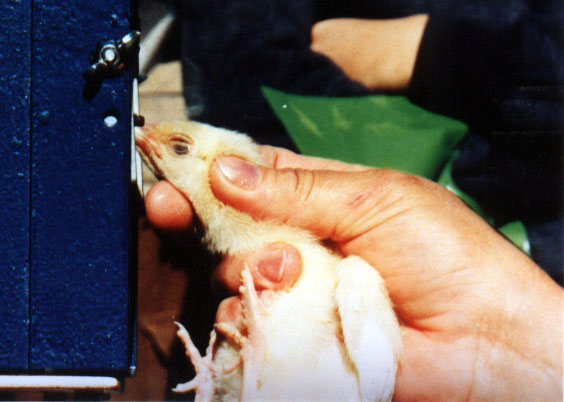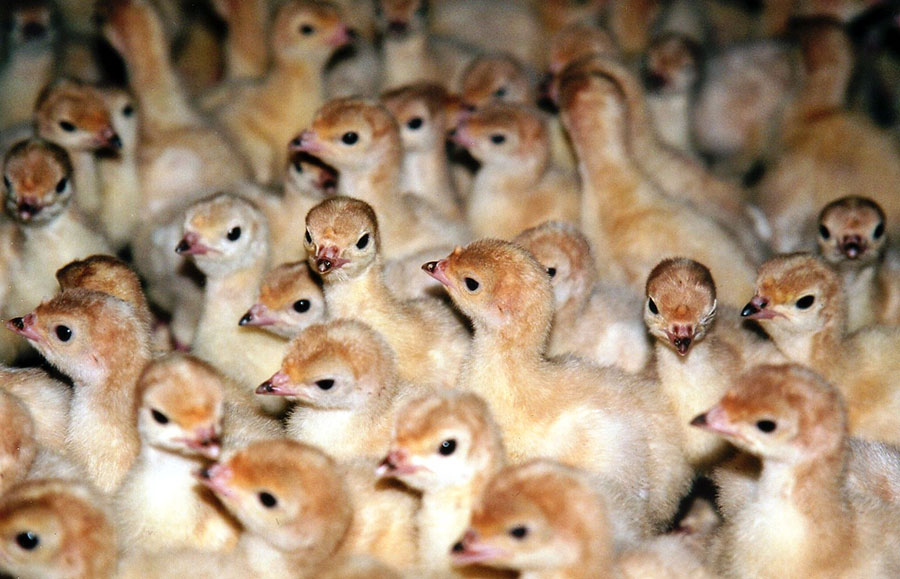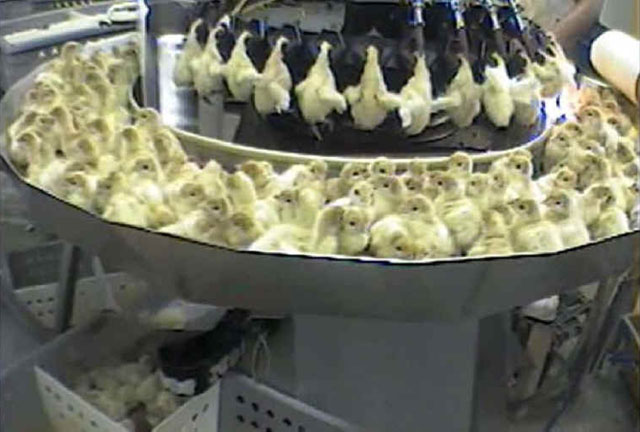Debeaking Birds Has Got to Stop
“Stop talking about ‘debeaking’ a chicken. Instead, let’s call it ‘beak conditioning.’” – Timothy Cummings, DVM, Mississippi State University

This suggestion was made by a veterinarian speaking to poultry producers in Starkville, Mississippi, at a Turkey Meeting sponsored by the Arkansas Poultry Federation on September 21 and reported in the Arkansas Democrat-Gazette, September 22, 2007. According to Cummings, “Words like debeaking, hanging and detoeing used in the poultry industry give extra fodder to groups that seek its destruction.” You can read the article with UPC’s response at www.upc-online.org/debeaking/92507ak.html.
The following discussion is from the revised edition of Karen Davis’s book Prisoned Chickens, Poisoned Eggs: An Inside Look at the Modern Poultry Industry. The new edition of the book is being published in 2008 by the Book Publishing Company.
The emotion-laden word “mutilation” is sometimes used in describing husbandry practices such as removing a portion of a hen’s beak. . . [However] removal of certain bodily structures, although causing temporary pain to individuals, can be of much benefit to the welfare of the group. – James V. Craig, Domestic Animal Behavior, 1981, pp. 243-244.
Feather pecking is NOT aggression; rather it’s foraging behaviour gone wrong. The solution of industry is to chop off beaks. – Ian Duncan, University of Guelph Professor of Poultry Science speaking at a conference in Vancouver, BC, November 7, 2006.
Beak-trimming will always cause a deprivation of sensory input in the beak, an important source of information in birds, and the end goal should be the avoidance of beak-trimming altogether through genetics, housing conditions, and management. – Philip C. Glatz, ed., Beak Trimming, 2005, p. 77.
Egg producers remove a portion of hens’ beaks with machinery, and without painkillers, to reduce the feather pecking that can occur in birds confined with no outlet for their normal foraging, dustbathing, and exploratory activities. Debeaked birds suffer acute and chronic pain in their beaks, heads and faces, because the nerves of the beak are connected to the nerves in the face and the brain which start to develop when the embryo is two days old (Glatz, p. 47). Debeaked birds cannot grasp their food efficiently, and they have trouble preening themselves and grooming the faces of their flock mates, which can cause them to appear to be “aggressive,” when all they are trying to do is remove bits of debris that a normal beak grasps easily.
Rough handling, yelling and being grabbed by the head, neck, tail or wing, as operators shove the birds’ faces up against and into the debeaking machinery, then pull the birds violently away and toss them into containers, causes broken bones, torn and twisted beaks and injuries to their delicate joints.

In the 1920s, farmers began raising chickens indoors on wire floors. Crowded together with no opportunity to scratch, dustbathe, and explore, the birds started picking at each other. Instead of rectifying the environment, farmers chose beak mutilation. In the 1930s and ‘40s, a San Diego, California farmer named T.E. Wolfe used a gas torch to burn off part of the upper beaks of his hens. Later his neighbor adapted a soldering iron by giving it a chisel edge that enabled operators to apply downward pressure on the bird’s upper beak to sear and cauterize it. In 1942-1943, the San Diego company Lyon Electric developed and registered the first “Debeaker” machine. The company is still in business.
Chickens raised for meat are no longer debeaked because “meat-type” chickens are slaughtered as six-week old babies, before they are old enough to form a social order. By contrast, hens used to produce eggs for human consumption and roosters used for breeding in the egg and meat industries are debeaked between the ages of one-day-old and five months old. Likewise, turkeys, pheasants, quails, and guinea fowl are debeaked and ducks are debilled. So-called “free-range” and “cage-free” chickens and turkeys are usually debeaked at the hatchery as well.
Poultry producers used to deceive the public that a beak was as insensitive as the tip of a fingernail, but this assertion can no longer be made because decades of research have refuted it. Debeaking was fully explored by the Brambell Committee, a group of veterinarians and other experts appointed by the British Parliament to investigate welfare concerns arising from Ruth Harrison’s expose of factory farming – Harrison coined the term “factory farming” – in her book Animal Machines, published in 1964. In 1965, the Brambell Committee said “beak-trimming should be stopped immediately in caged birds and within two years for non-caged birds.”
The Committee explained: “The upper mandible of the bird consists of a thin layer of horn covering a bony structure of the same profile which extends to within a millimeter or so of the tip of the beak. Between the horn and bone [of the beak] is a thin layer of highly sensitive soft tissue, resembling the quick of the human nail. The hot knife blade used in debeaking cuts through this complex of horn, bone and sensitive tissue causing severe pain.”
Acute and Chronic PainIn 1993, Ian Duncan, a poultry researcher at the University of Guelph in Ontario, said “there is now good morphological, neurophysiological, and behavioral evidence that beak trimming leads to both acute and chronic pain,” including phantom limb pain. Poultry producers use the term “beak tenderness” to describe conditions that prompt advice about the need for deep feed troughs to prevent the wounded beak from bumping the bottom of the trough resulting in starve-outs. Machine operators are reminded to do the “very tedious task” of beak trimming carefully, because “too often it is done carelessly” causing eyes to be “seared” and “blisters in the mouth.”
“Further Research”Debeaking experiments are a worldwide enterprise. The 2005 book, Beak Trimming, edited by Philip C. Glatz, contains 27 pages of published experiments covering 40 years. (Countless other experiments have never been published.) Despite the “wealth of scientific information on the welfare of beak-trimmed birds, beak-trimming methods and alternatives to beak-trimming,” according to Beak Trimming, “there is a lack of comprehensive studies that measure the effect of beak-trimming on welfare using multiple indicators (physiological as well as behavioural) and it is hard to compare between studies due to different methods of beak-trimming and beak-trimming at different ages” (Glatz, p. 77). More research is “needed.” Etc. Etc.
Debeaking methods include the use of hot blades, cold blades, soldering irons, jackknives, pruning shears, dog nail clippers, liquid nitrogen used to “declaw emus,” machines consisting of “a hot plate and cutting bar operated by means of a foot lever,” robotic beak trimmers where chicks are loaded onto the robot by hand, with “holding cups around their heads,” chemical debeaking using capsaicin, “a cheap non toxic substance extracted from hot peppers that causes depletion of certain neuropeptides from sensory nerves in birds,” infrared beak treatment machines that cause the affected part of the beak to soften and “erode away,” and laser machines that cut the beak tissue with “intense emissions of light” and heat absorption.
The suffering of the birds subjected to these torturous surgeries is played down by many (not all) of the experimenters. For example, in one experiment, newborn chicks whose beaks were cut with an ophthalmic laser were said to “vocalize” in response to an increase in “energy density” indicating they were feeling “discomfort” when the laser failed to cut the inner bone of their beaks, seemingly “due to the lack of [electrical] power” (Glatz, p. 9).
A machine called a Bio-Beaker, developed in Millsboro, Delaware in the 1980s, uses a high voltage electrical current to burn a hole in the upper beak that’s supposed to cause it to fall off in about a week. The birds “struggle” as their beaks are shoved into the instrument and “struggle” again when the electricity is administered, and they often have to be debeaked a second time to correct a botched job and because young birds’ beaks can grow back. Used on turkeys, the Bio-Beaker is said to be “more successful” than with chickens, although “operator errors and inconsistencies have caused welfare problems for turkeys” (Glatz, p. 10). Perhaps the Bio-Beaker (or the laser machine) is responsible for the blackened, necrotic, crumbling beaks of baby turkeys photographed by investigators in recent visits to U.S. turkey farms.
For example, East Bay Animal Advocates (ebaa.blogspot.com) recently found horrible conditions at Diestel Turkey Ranch, a so-called “free range/organic” turkey farm in California and a supplier to Whole Foods Market, which claims to have “Animal Compassionate Standards.” The photo above shows young turkeys at Diestel with blackened necrotic beaks. Despite the exposure of Diestel, Whole Foods continues doing business with them.

Baby Turkeys on Laser Debeaking Carousel

Please contact the following industry groups and demand an end to debeaking. Request a written response.
-
Whole Foods Market
Whole Foods claims to be a leader in developing “compassionate standards” for the producers of animal products sold in its stores. Debeaking is not a compassionate practice, so what is John Mackey, president of Whole Foods, going to do about it?
John Mackey, Chairman, President
Whole Foods Market
2700 Wilson Boulevard
Arlington, VA 22201-3804
Comments can be posted to John Mackey and Whole Foods on the Web at:
http://center.spoke.com/info/pLmQCv/JohnMackey and
http://www.wholefoodsmarket.com/contact/contact.html National Turkey Federation
The National Turkey Federation represents the U.S. turkey industry. NTF doesn’t seem to have any “welfare” standards.
Ted Seger, Chairman
Joel Brandenberger, President
National Turkey Federation
1225 New York Avenue NW, Suite 400
Washington, DC 20005
Phone: 202-898-0100
Fax: 202-898-0203
Email: info@turkeyfed.org
Website: http://www.eatturkey.com/about/about.htmlUnited Egg Producers
United Egg Producers represents the U.S. egg industry. UEP’s “animal care” guidelines include “standards for trimming of chicks’ beaks.”
Gene Gregory, President & CEO
United Egg Producers
1720 Windward Concourse, Suite 230
Alpharetta, GA 30005
Phone: 770-360-9220
Fax: 770-360-7058
Email: info@unitedegg.com
gene@unitedegg.com
Website: http://www.unitedegg.org/contact.aspx